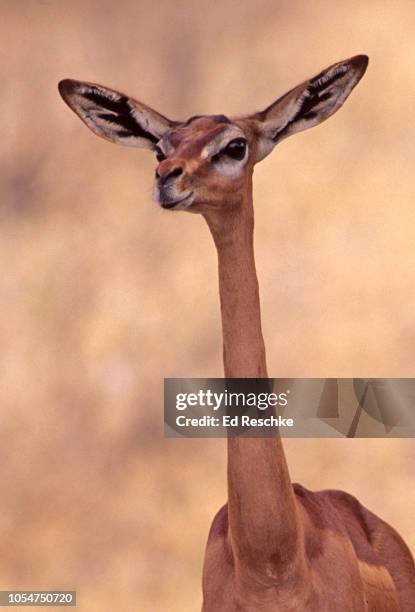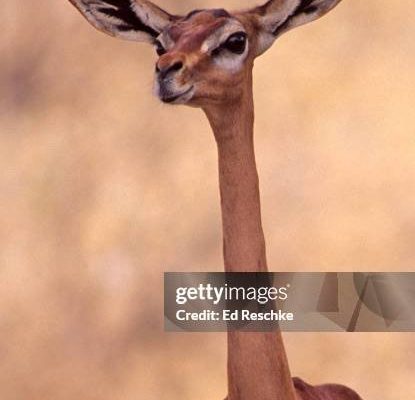
So, how smart is a gerenuk, really? Let’s dive into their world to explore their cognitive abilities and behavior. Just like a good cup of coffee, understanding these creatures requires a bit of warmth and patience. We’ll look at everything from their social interactions to their ability to adapt to harsh environments, shedding light on just how these intriguing animals operate.
What Is a Gerenuk?
Before we dive into their smarts, let’s get to know the gerenuk a little better. Gerenuks are medium-sized antelopes native to the dry regions of East Africa, primarily found in countries like Kenya and Somalia. They have a distinctive long neck, which is quite unlike other antelopes, giving them the ability to reach leaves and branches that others can’t. *Their name, which means “giraffe neck” in Somali, fits them perfectly!*
These antelopes typically stand about 3 to 4 feet tall at the shoulder, making them relatively slender and graceful. Their coloring varies from a light reddish-brown to a more grayish hue, providing excellent camouflage against the arid landscape. One of the most noticeable features of the gerenuk is its large eyes and ears, which not only enhance its vision and hearing but also contribute to its ability to communicate with others.
Gerenuks are social creatures that often congregate in small groups. Their sharp eyesight helps them stay alert for predators like lions and leopards, which are always a concern in the wild. But the fascinating part is how they interact with other animals and solve problems in their habitat—let’s delve deeper into their cognitive abilities!
Cognitive Abilities of Gerenuks
You might be surprised to find out that gerenuks exhibit a range of cognitive abilities that reflect their ability to survive in challenging environments. These animals display impressive memory skills, especially when it comes to locating food sources and identifying potential threats. In the wild, they must remember where to find the best feeding spots and how to navigate their terrain—a task that requires significant mental effort.
Their problem-solving skills are also noteworthy. For example, when faced with situations where food is out of reach, gerenuks can stand on their hind legs to stretch their necks and access leaves higher up. This ability to adapt and find solutions is a sign of their intelligence. Here’s the thing: being smart in the animal kingdom often means being resourceful, and gerenuks have this down to an art.
What’s interesting is that gerenuks also display social intelligence. They are able to communicate with each other through a variety of vocalizations and body language. This helps them warn one another of impending danger or signal when it’s time to move to a new location. Imagine talking to your friends using gestures and sounds—this is how they maintain their social bonds and navigate relationships within their groups.
Behavioral Traits of Gerenuks
Behavior is a huge part of understanding intelligence, and gerenuks showcase some fascinating traits. For starters, they are generally quite curious animals. You might see one on grassy plains, cautiously exploring its surroundings. This curiosity helps them learn about potential dangers and the layout of their habitat, ensuring they can navigate successfully.
Gerenuks are also known for their adaptability. They can thrive in harsh environments where food sources are scarce. The ability to survive on leaves and shrubs that other animals might avoid is a testament to their flexibility. When food is limited, they can go for extended periods without water, relying on moisture from their food. This kind of resilience is a sign of survival intelligence.
Another key behavior is their grooming habits. Regularly grooming themselves and each other not only keeps them clean but also strengthens their social bonds. Grooming is a way for them to communicate trust and affection, reflecting a level of emotional intelligence that many might not expect from wildlife.
Social Structure and Interaction
Gerenuks usually form small groups, often consisting of a few females and their young, or a single male with multiple females. This social structure plays a significant role in their survival. By sticking together, they can look out for each other against predators. When one gerenuk spots danger, the others are alerted right away, showcasing their collaborative smarts.
Interestingly, males often display territorial behaviors, marking their territory with scent markings to warn other males. They engage in ritualized displays of dominance, which can include vocalizations and physical posturing. This behavior helps maintain social order and reduces the likelihood of physical conflict among males.
You might be wondering about how they communicate. Gerenuks utilize a range of vocal sounds, including grunts and whistles, to convey different messages. For instance, a high-pitched alert might signal danger, while softer sounds could indicate calm within the group. Their ability to understand and react to these sounds reflects their social intelligence and highlights how interconnected they are with their environment.
Gerenuks and Their Environment
The environment greatly influences the behaviors and cognitive abilities of gerenuks. Living in arid and semi-arid habitats, they have adapted to find water and food in ways unique to their kind. As herbivores, they often forage on acacia leaves and other shrubs, demonstrating their ability to identify which plants provide optimal sustenance.
Seasonal changes also play a pivotal role. During dry seasons, they may shift their diet and movements in search of greener pastures. This adaptability speaks volumes about their intelligence; they can quickly adjust to changing conditions, ensuring their survival.
Interestingly, gerenuks are known to share their habitat with other species, such as gazelles and various birds. This coexistence often leads to *mutual benefits*, as many of these animals alert each other to the presence of predators. The ability to navigate these complex relationships shows their understanding of the ecosystem they inhabit.
Conservation and Importance of Gerenuks
Understanding how smart gerenuks are can significantly impact conservation efforts. As their habitats face threats from human encroachment and climate change, recognizing their intelligence can help us appreciate their role in the ecosystem. They are not just another antelope; they are a vital part of the biodiversity that keeps our planet healthy.
Conservationists focus on protecting their habitats and creating awareness about the challenges these animals face. By fostering a better understanding of their behavior and cognitive abilities, we can encourage more significant efforts to preserve their population. After all, intelligent species often play critical roles in their environments, and losing them could disrupt ecological balance.
Efforts like protected reserves and educational programs help ensure that future generations can witness these fascinating creatures. Plus, understanding how smart gerenuks are can inspire admiration and respect for wildlife as a whole, emphasizing the need to protect not just them but all creatures that share our planet.
In conclusion, the cognitive abilities and behaviors of gerenuks paint a picture of a resourceful and intelligent creature. From their problem-solving skills to their social structures, these animals showcase a level of intelligence that is both fascinating and essential for survival in challenging environments. As we learn more about their unique adaptations, we can appreciate the complexity of the natural world and the roles each species plays.
So, the next time you think about intelligence in animals, remember the gerenuk. They may not be the flashiest or most recognized creatures, but their cleverness and social skills deserve our attention and respect. By understanding them better, we can contribute to their conservation and ensure that these beautiful antelopes continue to thrive in the wild.

